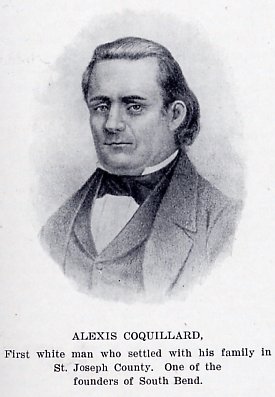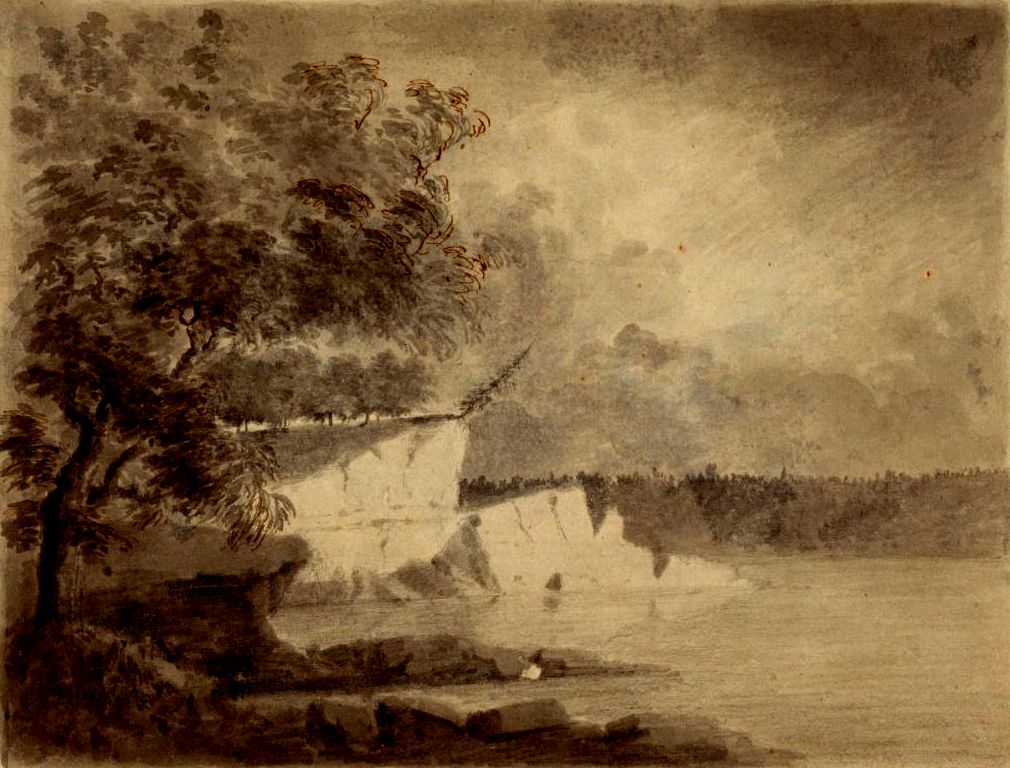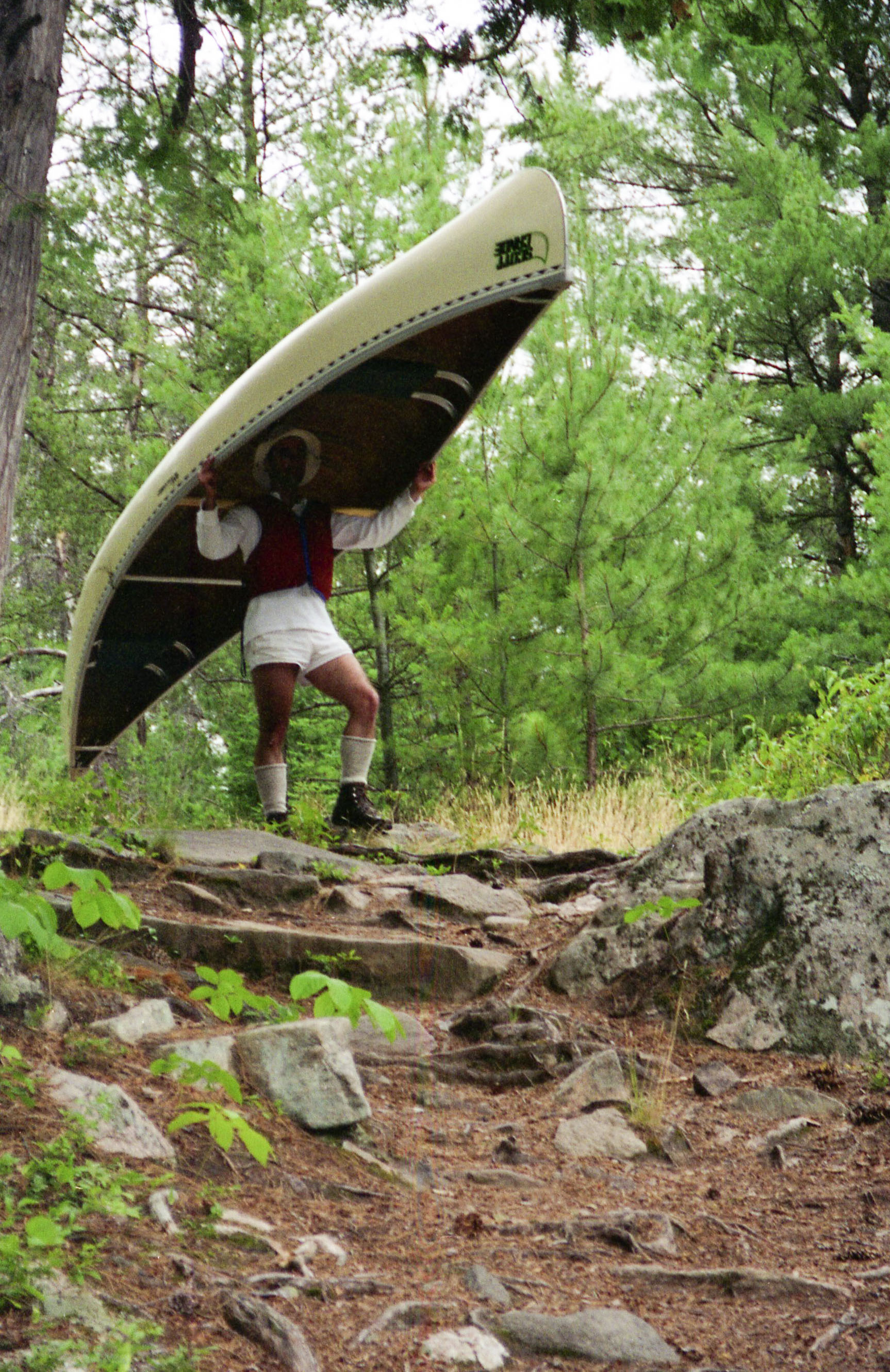|
Fort Miami (Indiana)
Fort Miami, originally called Fort St. Philippe or Fort des Miamis, were a pair of French built palisade forts established at Kekionga, the principal village of the Miami. These forts were situated where the St. Joseph River and St. Marys River merge to form the Maumee River in Northeastern Indiana, where present day Fort Wayne is located. The forts and their key location on this confluence allowed for a significant hold on New France (and later the Old Northwest) by whomever was able to control the area, both militarily for its strategic location and economically as it served as a gateway and hotbed for lucrative trade markets such as fur. It therefore played a pivotal role in a number of conflicts including the French and Indian Wars, Pontiac's War, and the Northwest Indian War, while other battles occurred nearby including La Balme's Defeat and the Harmar campaign. The first construct was a small trading post built by Jean Baptiste Bissot, Sieur de Vincennes around 1706, ... [...More Info...] [...Related Items...] OR: [Wikipedia] [Google] [Baidu] |
New France
New France (, ) was the territory colonized by Kingdom of France, France in North America, beginning with the exploration of the Gulf of Saint Lawrence by Jacques Cartier in 1534 and ending with the cession of New France to Kingdom of Great Britain, Great Britain and History of Spain (1700–1808), Spain in 1763 under the Treaty of Paris (1763), Treaty of Paris. A vast viceroyalty, New France consisted of five colonies at its peak in 1712, each with its own administration: Canada (New France), Canada, the most developed colony, which was divided into the districts of Quebec (around what is now called Quebec City), Trois-Rivières, and Montreal; Hudson Bay; Acadia in the northeast; Terre-Neuve (New France), Terre-Neuve on the island of Newfoundland (island), Newfoundland; and Louisiana (New France), Louisiana. It extended from Newfoundland to the Canadian Prairies and from Hudson Bay to the Gulf of Mexico, including all the Great Lakes of North America. The continent-traversing ... [...More Info...] [...Related Items...] OR: [Wikipedia] [Google] [Baidu] |
Jacques-Charles Renaud Dubuisson
Jacques-Charles Renaud Dubuisson (1666–1739) was born in France and came to New France in 1685. Renaud was a career soldier and, aside from a dueling incident, was consistently praised for his military and administrative work. His most important military work was among the Miami Indians where he was responsible for assisting with the work of Jean-Baptiste Bissot, Sieur de Vincennes in keeping the Miami from joining forces with the English. After Bissot's death in 1719, he established a number of garrison posts, one of which was commanded by François-Marie Bissot de Vinsenne. Dubuisson was the post commander at Detroit in 1712. He commanded a post at the Miamis near Toledo from 1723 to 1727. By 1729, he was appointed post commander at Michilimackinac Michilimackinac ( ) is derived from an Ottawa Ojibwe name for present-day Mackinac Island and the region around the Straits of Mackinac between Lake Huron and Lake Michigan.. Early settlers of North America applied the ter ... [...More Info...] [...Related Items...] OR: [Wikipedia] [Google] [Baidu] |
Philippe De Rigaud Vaudreuil
Philippe de Rigaud, Marquis de Vaudreuil (; c. 1643 – 10 October 1725) was a French military officer who served as Governor General of New France (now Canada and U.S. states of the Mississippi Valley) from 1703 to 1725, throughout Queen Anne's War and Father Rale's War. Life and career He was born at the Castle of Vaudreuil near Castelnaudary in France. He was the second son of Jean-Louis de Rigaud (d. 1659), Baron de Vaudreuil, Seigneur d' Auriac and de Cabanial, by his wife Marie de Château-Verdun. She was the daughter of François, Seigneur de la Razairie. As Chevalier de Vaudreuil, he was sent to command French forces in New France before being appointed Governor of Montreal in 1699, and then Governor General of New France in 1703. He died at Quebec City. He married Louise Élisabeth de Joybert, a daughter of Pierre de Joybert de Soulanges et de Marson, by his wife Marie-Françoise, daughter of Louis-Théandre Chartier de Lotbinière. They lived at Château Vaudreuil, ... [...More Info...] [...Related Items...] OR: [Wikipedia] [Google] [Baidu] |
South Bend, Indiana
South Bend is a city in St. Joseph County, Indiana, United States, and its county seat. It lies along the St. Joseph River (Lake Michigan), St. Joseph River near its southernmost bend, from which it derives its name. It is the List of cities in Indiana, fourth-most populous city in Indiana with a population of 103,453 at the 2020 United States census, 2020 census. Located directly south of Indiana's northern border with Michigan, South Bend anchors the broader Michiana region. Its South Bend-Mishawaka metropolitan area, metropolitan area had a population of 324,501 in 2020, while its combined statistical area had 812,199 residents. The area was first settled in the early 19th century by fur traders and was established as a city in 1865. The St. Joseph River shaped South Bend's economy through the mid-20th century. River access assisted heavy industrial development such as that of the Studebaker, Studebaker Corporation and the Oliver Corporation, Oliver Chilled Plow Company. Lik ... [...More Info...] [...Related Items...] OR: [Wikipedia] [Google] [Baidu] |
Wabash River
The Wabash River () is a U.S. Geological Survey. National Hydrography Dataset high-resolution flowline dataThe National Map accessed May 13, 2011 river that drains most of the state of Indiana, and a significant part of Illinois, in the United States. It flows from the headwaters in Ohio, near the Indiana border, then southwest across northern Indiana turning south near the Illinois border, where the southern portion forms the Indiana-Illinois border before flowing into the Ohio River. It is the largest northern tributary of the Ohio River and third largest overall, behind the Cumberland River, Cumberland and Tennessee River, Tennessee rivers. From the dam near Huntington, Indiana, to its terminus at the Ohio River, the Wabash flows freely for The Tippecanoe River, White River (Indiana), White River, Embarras River (Illinois), Embarras River and Little Wabash River are major tributaries. The river's name comes from a Miami-Illinois language, Miami word meaning "water over whi ... [...More Info...] [...Related Items...] OR: [Wikipedia] [Google] [Baidu] |
Antoine De La Mothe Cadillac
Antoine de la Mothe, sieur de Cadillac (, ; March 5, 1658October 16, 1730), born Antoine Laumet, was a French explorer and adventurer in New France, which stretched from Eastern Canada to Louisiana on the Gulf of Mexico. He rose from a modest beginning in Acadia in 1683 as an explorer, trapper, and a trader of alcohol and furs, achieving various positions of political importance in the colony. He was the commander of Fort de Buade in St. Ignace, Michigan, in 1694. In 1701, he founded Fort Pontchartrain du Détroit (which became the city of Detroit); he was commandant of the fort until 1710. Between 1710 and 1716, he was the governor of Louisiana, although he did not arrive in that territory until 1713.Brasseaux, 2000 His knowledge of the coasts of New England and the Great Lakes area was appreciated by Frontenac, governor of New France, and Pontchartrain, Secretary of State for the Navy. This earned him various favors, including the Order of Saint Louis from King Louis XIV. ... [...More Info...] [...Related Items...] OR: [Wikipedia] [Google] [Baidu] |
Iroquois
The Iroquois ( ), also known as the Five Nations, and later as the Six Nations from 1722 onwards; alternatively referred to by the Endonym and exonym, endonym Haudenosaunee ( ; ) are an Iroquoian languages, Iroquoian-speaking Confederation#Indigenous confederations in North America, confederacy of Native Americans in the United States, Native Americans and First Nations in Canada, First Nations peoples in northeast North America. They were known by the French during the Colonial history of the United States, colonial years as the Iroquois League, and later as the Iroquois Confederacy, while the English simply called them the "Five Nations". Their country has been called wikt:Iroquoia, Iroquoia and Haudenosauneega in English, and '':fr:Iroquoisie, Iroquoisie'' in French. The peoples of the Iroquois included (from east to west) the Mohawk people, Mohawk, Oneida people, Oneida, Onondaga people, Onondaga, Cayuga people, Cayuga, and Seneca people, Seneca. After 1722, the Iroquoian-sp ... [...More Info...] [...Related Items...] OR: [Wikipedia] [Google] [Baidu] |
Lake Erie
Lake Erie ( ) is the fourth-largest lake by surface area of the five Great Lakes in North America and the eleventh-largest globally. It is the southernmost, shallowest, and smallest by volume of the Great Lakes and also has the shortest average water lake retention time, residence time. At its deepest point, Lake Erie is deep, making it the only Great Lake whose deepest point is above sea level. Located on the Canada–United States border, International Boundary between Canada and the United States, Lake Erie's northern shore is the Provinces and territories of Canada, Canadian province of Ontario, specifically the Ontario Peninsula, with the U.S. states of Michigan, Ohio, Pennsylvania, and New York (state), New York on its western, southern, and eastern shores. These jurisdictions divide the surface area of the lake with water boundaries. The largest city on the lake is Cleveland, anchoring the third largest U.S. metro area in the Great Lakes region, after Chicago metropoli ... [...More Info...] [...Related Items...] OR: [Wikipedia] [Google] [Baidu] |
Great Black Swamp
The Great Black Swamp (also known simply as the Black Swamp) was a glacier, glacially fed wetland in northwest Ohio and Northern Indiana, northeast Indiana, United States, that existed from the end of the Wisconsin glaciation until the late 19th century. Comprising extensive swamps and marshes, with some higher, drier ground interspersed, it occupied what was formerly the southwestern part of Proglacial lake, proglacial Lake Maumee, a Holocene precursor to Lake Erie. The area was about wide (north to south) and long, covering an estimated ; other estimates put the area of the swamp at . Gradually drained and settled in the second half of the 19th century, it is now highly productive farmland. However, this development has been detrimental to the ecosystem as a result of agricultural pollution, agricultural runoff. This runoff, in turn, has contributed to frequent toxic Algal bloom, algal blooms in Lake Erie. The land once covered by the swamp lies primarily within the Maumee ... [...More Info...] [...Related Items...] OR: [Wikipedia] [Google] [Baidu] |
Portage
Portage or portaging ( CA: ; ) is the practice of carrying water craft or cargo over land, either around an obstacle in a river, or between two bodies of water. A path where items are regularly carried between bodies of water is also called a ''portage.'' The term comes from French, where means "to carry", as in "portable". In Canada, the term "carrying-place" was sometimes used. Early French explorers in New France and French Louisiana encountered many rapids and cascades. The Native Americans carried their canoes over land to avoid river obstacles. Over time, important portages were sometimes provided with canals with locks, and even portage railways. Primitive portaging generally involves carrying the vessel and its contents across the portage in multiple trips. Small canoes can be portaged by carrying them inverted over one's shoulders and the center strut may be designed in the style of a yoke to facilitate this. Historically, voyageurs often employed tump lines on t ... [...More Info...] [...Related Items...] OR: [Wikipedia] [Google] [Baidu] |
Beaver Wars
The Beaver Wars (), also known as the Iroquois Wars or the French and Iroquois Wars (), were a series of conflicts fought intermittently during the 17th century in North America throughout the Saint Lawrence River valley in Canada and the Great Lakes region which pitted the Iroquois against the Hurons, northern Algonquian peoples, Algonquians and their French allies. As a result of this conflict, the Iroquois destroyed several confederacies and tribes through warfare: the Hurons or Wendat, Erie people, Erie, Neutral Nation, Neutral, Wenro, Petun, Susquehannock, Mohicans, Mohican and northern Algonquins whom they defeated and dispersed, some fleeing to neighbouring peoples and others assimilated, routed, or killed. The Iroquois sought to expand their territory to monopolize the fur trade with European markets. They originally were a confederacy of the Mohawk people, Mohawk, Oneida people, Oneida, Onondaga people, Onondaga, Cayuga people, Cayuga, and Seneca people, Seneca tribes in ... [...More Info...] [...Related Items...] OR: [Wikipedia] [Google] [Baidu] |






